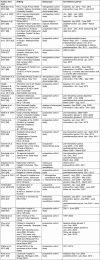Preventive bundles to reduce catheter-associated bloodstream infections in neonatal intensive care
- PMID: 30588416
- PMCID: PMC6289088
- DOI: 10.3205/dgkh000316
Preventive bundles to reduce catheter-associated bloodstream infections in neonatal intensive care
Abstract
This systematic survey includes a total of 27 studies published between 2002 and 2016 on the benefit of preventive bundles for the prevention of central-line associated bloodstream infections (CLABSI) in neonatal intensive care. These studies are mainly cohort studies or studies analyzing an interrupted time series before and after intervention. The studies showed heterogeneity in terms of endpoint definitions (CLABSI), details of the implemented measures, and evidence of a publication bias favoring the use of of preventive bundles. The cumulative analysis showed a statistically and clinically significant benefit of preventive bundles to avoid CLABSI in neonatal intensive care.
In einer systematischen Übersicht zu neonatologischen Intensivpatienten mit zentralem Venenkatheter wurden die Ergebisse von insgesamt 27 Studien ausgewertet, die den Nutzen von Präventionsbündeln zur Vermeidung von katheterassoziierten Blutstrominfektionen (CLABSI) untersucht haben. Die eingeschlossenen Studien wurden zwischen 2002 und 2016 publiziert. Die meisten Studien waren Kohortenstudien oder unterbrochene Zeitserien vor und nach Einführung von Präventionsbündeln. Entsprechend heterogen sind die Definitionen der Endpunkte und die unterschiedlichen präventiven Maßnahmen; zudem gab es Hinweise auf einen Publikationsbias zugunsten von Präventionsbündeln. Trotz dieser methodischen Limitationen zeigen die analysierten Studien einen signifikanten und klinisch sehr relevanten Nutzen von Präventionsbündeln in der neonatologischen Intensivpflege.
Keywords: central-line associated bloodstream infection; neonatal intensive care; preterm infants; preventive bundle.
Conflict of interest statement
The authors declare that there are no conflicts of interest. Prof. Simon is coordinator of the working group on neonatal intensive care of the German Commission for Hospital Hygiene and Infection Prevention affiliated to the Robert Koch Institute in Berlin, Germany. Prof. Geffers is leader of the NEO-KISS surveillance module of the German National Reference Center for Surveillance of Nosocomial Infections, Institute for Hygiene and Environmental Medicine at the Charité in Berlin, Germany.
Figures






Similar articles
-
Central line bloodstream infections can be reduced in newborn infants using the modified Seldinger technique and care bundles of preventative measures.Acta Paediatr. 2015 Apr;104(4):e152-7. doi: 10.1111/apa.12915. Acta Paediatr. 2015. PMID: 25545676
-
Impact of central line bundle for prevention of umbilical catheter-related bloodstream infections in a neonatal intensive care unit: A pre-post intervention study.Am J Infect Control. 2019 Apr;47(4):387-390. doi: 10.1016/j.ajic.2018.10.002. Epub 2018 Nov 28. Am J Infect Control. 2019. PMID: 30502109
-
A Central Line Care Maintenance Bundle for the Prevention of Central Line-Associated Bloodstream Infection in Non-Intensive Care Unit Settings.Infect Control Hosp Epidemiol. 2016 Jun;37(6):692-8. doi: 10.1017/ice.2016.32. Epub 2016 Mar 21. Infect Control Hosp Epidemiol. 2016. PMID: 26999746 Free PMC article. Clinical Trial.
-
The Use and Effectiveness of Bundles for Prevention of Central Line-Associated Bloodstream Infections in Neonates: A Review of the Literature.J Perinat Neonatal Nurs. 2016 Apr-Jun;30(2):148-59. doi: 10.1097/JPN.0000000000000171. J Perinat Neonatal Nurs. 2016. PMID: 27104606 Review.
-
Effectiveness of insertion and maintenance bundles in preventing peripheral intravenous catheter-related complications and bloodstream infection in hospital patients: A systematic review.Infect Dis Health. 2019 Aug;24(3):152-168. doi: 10.1016/j.idh.2019.03.001. Epub 2019 Apr 18. Infect Dis Health. 2019. PMID: 31005606
Cited by
-
Good handling practice of parenterally administered medicines in neonatal intensive care units - position paper of an interdisciplinary working group.GMS Hyg Infect Control. 2023 May 3;18:Doc10. doi: 10.3205/dgkh000436. eCollection 2023. GMS Hyg Infect Control. 2023. PMID: 37261055 Free PMC article.
-
Catheter care bundle and feedback to prevent central line-associated bloodstream infections in pediatric patients.Clin Exp Pediatr. 2021 Mar;64(3):119-120. doi: 10.3345/cep.2020.01186. Epub 2020 Dec 8. Clin Exp Pediatr. 2021. PMID: 33332952 Free PMC article. No abstract available.
-
Impact of postnatal age on neonatal intensive care unit bloodstream infection reporting.Am J Infect Control. 2021 Sep;49(9):1191-1193. doi: 10.1016/j.ajic.2021.03.018. Epub 2021 Apr 2. Am J Infect Control. 2021. PMID: 33819494 Free PMC article.
-
Practice variations and rates of late onset sepsis and necrotizing enterocolitis in very preterm born infants, a review.Transl Pediatr. 2019 Jul;8(3):212-226. doi: 10.21037/tp.2019.07.02. Transl Pediatr. 2019. PMID: 31413955 Free PMC article. Review.
-
The road to zero nosocomial infections in neonates-a narrative review.Acta Paediatr. 2021 Aug;110(8):2326-2335. doi: 10.1111/apa.15886. Epub 2021 May 6. Acta Paediatr. 2021. PMID: 33955065 Free PMC article. Review.
References
-
- Christoph J, Dame C, Eckmanns T, Gärtner B, Geffers C, Gille C, Haertel C, Haller S, Hartl D, Kraus-Haas M, Marschal M, Müller A, von Müller L, Simon A. Risikocharakterisierung intensivmedizinisch behandelter Früh- und Neugeborener und Daten zur Ist-Situation in deutschen neonatologischen Intensivpflegestationen 2013 – Fachliche Erläuterungen zu folgender Empfehlung: Praktische Umsetzung sowie krankenhaushygienische und infektionspräventive Konsequenzen des mikrobiellen Kolonisationsscreenings bei intensivmedizinisch behandelten Früh- und Neugeborenen. Ergänzende Empfehlung der Kommission für Krankenhaushygiene und Infektionsprävention (KRINKO) beim Robert Koch-Institut, Berlin zur Implementierung der Empfehlungen zur Prävention nosokomialer Infektionen bei neonatologischen Intensivpflegepatienten mit einem Geburtsgewicht unter 1.500 g aus dem Jahr 2007 und 2012 (Epidemiologisches Bulletin 42/2013) Epidemiol Bull. 2013;42 Suppl:1–52.
-
- Adcock PM, Stout GG, Hauck MA, Marshall GS. Effect of rapid viral diagnosis on the management of children hospitalized with lower respiratory tract infection. Pediatr Infect Dis J. 1997 Sep;16(9):842–846. doi: 10.1097/00006454-199709000-00005. http://dx.doi.org/10.1097/00006454-199709000-00005 Available from: - DOI - DOI - PubMed
-
- Cantey JB, Patel SJ. Antimicrobial stewardship in the NICU. Infect Dis Clin North Am. 2014 Jun;28(2):247–261. doi: 10.1016/j.idc.2014.01.005. http://dx.doi.org/10.1016/j.idc.2014.01.005 Available from: - DOI - DOI - PubMed
-
- Leistner R, Piening B, Gastmeier P, Geffers C, Schwab F. Nosocomial infections in very low birthweight infants in Germany: current data from the National Surveillance System NEO-KISS. Klin Padiatr. 2013 Mar;225(2):75–80. doi: 10.1055/s-0033-1334886. http://dx.doi.org/10.1055/s-0033-1334886 Available from: - DOI - DOI - PubMed
-
- Leistner R, Thürnagel S, Schwab F, Piening B, Gastmeier P, Geffers C. The impact of staffing on central venous catheter-associated bloodstream infections in preterm neonates – results of nation-wide cohort study in Germany. Antimicrob Resist Infect Control. 2013 Apr 4;2(1):11. doi: 10.1186/2047-2994-2-11. http://dx.doi.org/10.1186/2047-2994-2-11 Available from: - DOI - DOI - PMC - PubMed
LinkOut - more resources
Full Text Sources

